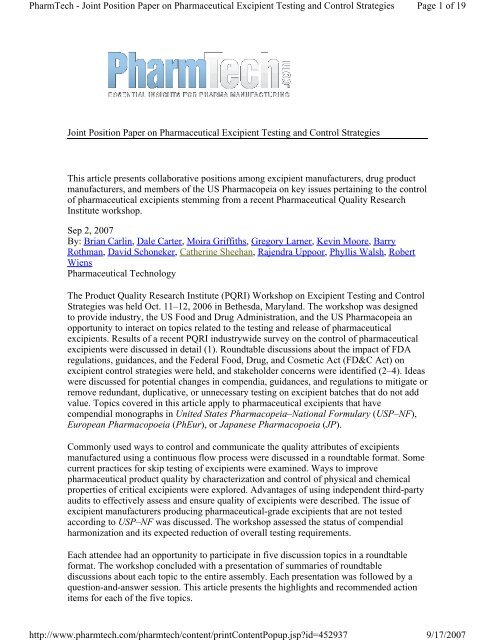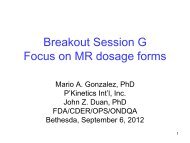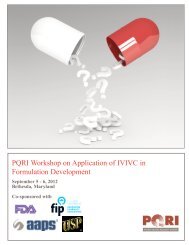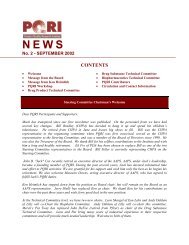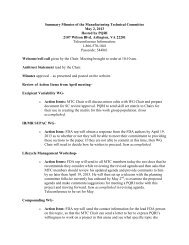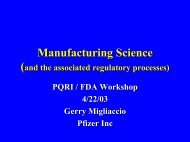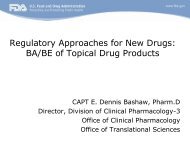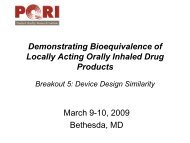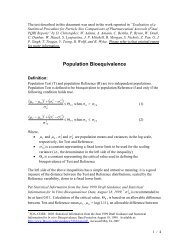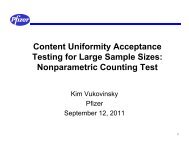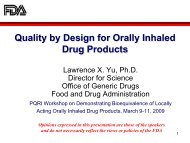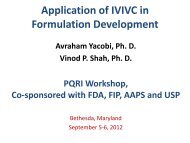Joint Position Paper on Pharmaceutical Excipient Testing and - PQRI
Joint Position Paper on Pharmaceutical Excipient Testing and - PQRI
Joint Position Paper on Pharmaceutical Excipient Testing and - PQRI
Create successful ePaper yourself
Turn your PDF publications into a flip-book with our unique Google optimized e-Paper software.
PharmTech - <str<strong>on</strong>g>Joint</str<strong>on</strong>g> <str<strong>on</strong>g>Positi<strong>on</strong></str<strong>on</strong>g> <str<strong>on</strong>g>Paper</str<strong>on</strong>g> <strong>on</strong> <strong>Pharmaceutical</strong> <strong>Excipient</strong> <strong>Testing</strong> <strong>and</strong> C<strong>on</strong>trol Strategies<br />
http://www.pharmtech.com/pharmtech/c<strong>on</strong>tent/printC<strong>on</strong>tentPopup.jsp?id=452937<br />
Page 1 of 19<br />
9/17/2007<br />
<str<strong>on</strong>g>Joint</str<strong>on</strong>g> <str<strong>on</strong>g>Positi<strong>on</strong></str<strong>on</strong>g> <str<strong>on</strong>g>Paper</str<strong>on</strong>g> <strong>on</strong> <strong>Pharmaceutical</strong> <strong>Excipient</strong> <strong>Testing</strong> <strong>and</strong> C<strong>on</strong>trol Strategies<br />
This article presents collaborative positi<strong>on</strong>s am<strong>on</strong>g excipient manufacturers, drug product<br />
manufacturers, <strong>and</strong> members of the US Pharmacopeia <strong>on</strong> key issues pertaining to the c<strong>on</strong>trol<br />
of pharmaceutical excipients stemming from a recent <strong>Pharmaceutical</strong> Quality Research<br />
Institute workshop.<br />
Sep 2, 2007<br />
By: Brian Carlin, Dale Carter, Moira Griffiths, Gregory Larner, Kevin Moore, Barry<br />
Rothman, David Sch<strong>on</strong>eker, Catherine Sheehan, Rajendra Uppoor, Phyllis Walsh, Robert<br />
Wiens<br />
<strong>Pharmaceutical</strong> Technology<br />
The Product Quality Research Institute (<strong>PQRI</strong>) Workshop <strong>on</strong> <strong>Excipient</strong> <strong>Testing</strong> <strong>and</strong> C<strong>on</strong>trol<br />
Strategies was held Oct. 11–12, 2006 in Bethesda, Maryl<strong>and</strong>. The workshop was designed<br />
to provide industry, the US Food <strong>and</strong> Drug Administrati<strong>on</strong>, <strong>and</strong> the US Pharmacopeia an<br />
opportunity to interact <strong>on</strong> topics related to the testing <strong>and</strong> release of pharmaceutical<br />
excipients. Results of a recent <strong>PQRI</strong> industrywide survey <strong>on</strong> the c<strong>on</strong>trol of pharmaceutical<br />
excipients were discussed in detail (1). Roundtable discussi<strong>on</strong>s about the impact of FDA<br />
regulati<strong>on</strong>s, guidances, <strong>and</strong> the Federal Food, Drug, <strong>and</strong> Cosmetic Act (FD&C Act) <strong>on</strong><br />
excipient c<strong>on</strong>trol strategies were held, <strong>and</strong> stakeholder c<strong>on</strong>cerns were identified (2–4). Ideas<br />
were discussed for potential changes in compendia, guidances, <strong>and</strong> regulati<strong>on</strong>s to mitigate or<br />
remove redundant, duplicative, or unnecessary testing <strong>on</strong> excipient batches that do not add<br />
value. Topics covered in this article apply to pharmaceutical excipients that have<br />
compendial m<strong>on</strong>ographs in United States Pharmacopeia–Nati<strong>on</strong>al Formulary (USP–NF),<br />
European Pharmacopoeia (PhEur), or Japanese Pharmacopoeia (JP).<br />
Comm<strong>on</strong>ly used ways to c<strong>on</strong>trol <strong>and</strong> communicate the quality attributes of excipients<br />
manufactured using a c<strong>on</strong>tinuous flow process were discussed in a roundtable format. Some<br />
current practices for skip testing of excipients were examined. Ways to improve<br />
pharmaceutical product quality by characterizati<strong>on</strong> <strong>and</strong> c<strong>on</strong>trol of physical <strong>and</strong> chemical<br />
properties of critical excipients were explored. Advantages of using independent third-party<br />
audits to effectively assess <strong>and</strong> ensure quality of excipients were described. The issue of<br />
excipient manufacturers producing pharmaceutical-grade excipients that are not tested<br />
according to USP–NF was discussed. The workshop assessed the status of compendial<br />
harm<strong>on</strong>izati<strong>on</strong> <strong>and</strong> its expected reducti<strong>on</strong> of overall testing requirements.<br />
Each attendee had an opportunity to participate in five discussi<strong>on</strong> topics in a roundtable<br />
format. The workshop c<strong>on</strong>cluded with a presentati<strong>on</strong> of summaries of roundtable<br />
discussi<strong>on</strong>s about each topic to the entire assembly. Each presentati<strong>on</strong> was followed by a<br />
questi<strong>on</strong>-<strong>and</strong>-answer sessi<strong>on</strong>. This article presents the highlights <strong>and</strong> recommended acti<strong>on</strong><br />
items for each of the five topics.
PharmTech - <str<strong>on</strong>g>Joint</str<strong>on</strong>g> <str<strong>on</strong>g>Positi<strong>on</strong></str<strong>on</strong>g> <str<strong>on</strong>g>Paper</str<strong>on</strong>g> <strong>on</strong> <strong>Pharmaceutical</strong> <strong>Excipient</strong> <strong>Testing</strong> <strong>and</strong> C<strong>on</strong>trol Strategies<br />
http://www.pharmtech.com/pharmtech/c<strong>on</strong>tent/printC<strong>on</strong>tentPopup.jsp?id=452937<br />
Page 2 of 19<br />
9/17/2007<br />
C<strong>on</strong>tinuous-flow manufacturing <strong>and</strong> skip-lot testing used for excipients in the c<strong>on</strong>text<br />
of 21 CFR Part 211.84 regulati<strong>on</strong>s<br />
The workshop topic descripti<strong>on</strong> was as follows:<br />
The definiti<strong>on</strong> of 'c<strong>on</strong>tinuous process' as currently used by excipient manufacturers does not<br />
clearly define a lot. This workshop will arrive at a comm<strong>on</strong>ly agreed definiti<strong>on</strong> of a 'lot' or<br />
'batch' in a c<strong>on</strong>tinuous-flow process <strong>and</strong> a comm<strong>on</strong>ly agreed way to c<strong>on</strong>trol quality of<br />
excipients manufactured using a c<strong>on</strong>tinuous-flow process. Skip-lot testing is not currently<br />
used effectively <strong>and</strong> efficiently by stakeholders, <strong>and</strong> this workshop will help identify <strong>and</strong><br />
discuss best practices for use of skip-lot testing.<br />
Survey results noted that less than 20% of drug-product manufacturers accept material based<br />
<strong>on</strong> excipient manufacturer's process c<strong>on</strong>trols <strong>and</strong> in-process tests not menti<strong>on</strong>ed <strong>on</strong> a<br />
certificate of analysis (CoA) but providing assurance of USP–NF requirements. This is an<br />
area where opportunities exist for excipient manufacturers <strong>and</strong> drug-product manufacturers<br />
to research <strong>and</strong> subsequently use informati<strong>on</strong> <strong>and</strong> knowledge that lie in the manufacturing<br />
process-c<strong>on</strong>trols <strong>and</strong> in-process test-result domains of an excipient manufacturer.<br />
Assessment of such informati<strong>on</strong> also could c<strong>on</strong>firm or otherwise indicate certain<br />
physicochemical quality aspects of an excipient batch or qualities of an excipient produced<br />
under c<strong>on</strong>tinuous manufacturing c<strong>on</strong>diti<strong>on</strong>s.<br />
Defining a batch <strong>and</strong> a lot for excipients produced by c<strong>on</strong>tinuous manufacturing. It was<br />
recognized that the definiti<strong>on</strong>s for a batch [21 CFR 210.3(b)(2)] or a lot [21 CFR 210.3(b)<br />
(10)] applicable to the manufacture of drug products can be applied in principle to the<br />
manufacture of excipients. According to current good manufacturing practice (CGMP)<br />
regulati<strong>on</strong>s for finished pharmaceuticals, a batch means a specific quantity of a drug or<br />
other material that is intended to have uniform character <strong>and</strong> quality, within specified limits,<br />
<strong>and</strong> is produced according to a single manufacturing order during the same cycle of<br />
manufacture [21 CFR 210.3(b)(2)]. Furthermore, a lot means a batch, or a specific identified<br />
porti<strong>on</strong> of a batch, having uniform character <strong>and</strong> quality within specified limits; or, in the<br />
case of a drug product produced by c<strong>on</strong>tinuous process, it is a specific identified amount<br />
produced in a unit of time or quantity in a manner that ensures its having uniform character<br />
<strong>and</strong> quality within specified limits [21 CFR 210.3(b)(10)].<br />
Workshop participants determined that c<strong>on</strong>tinuous flow processes can be compliant with the<br />
CGMP definiti<strong>on</strong>s of batches <strong>and</strong> lots. It was felt that for c<strong>on</strong>tinuous flow processes used to<br />
manufacture excipients, a batch or lot can be defined by an agreement between the excipient<br />
supplier or excipient manufacturer <strong>and</strong> drug product manufacturer.<br />
<strong>Testing</strong> excipient batches. The CGMP regulati<strong>on</strong>s for finished pharmaceuticals [21 CFR<br />
211.84(d)(1) <strong>and</strong> 21 CFR 211.84(d)(2)] require that before using an excipient in the<br />
manufacture of a drug product, the drug-product manufacturer must perform at least <strong>on</strong>e test<br />
to verify the excipient's identity <strong>and</strong> must dem<strong>on</strong>strate that the excipient c<strong>on</strong>forms to<br />
appropriate written specificati<strong>on</strong>s for purity, strength, <strong>and</strong> quality. The CGMP regulati<strong>on</strong>s<br />
also specify that in lieu of such testing by the drug-product manufacturer for purity,<br />
strength, <strong>and</strong> quality, a report of analysis may be accepted from the supplier of a comp<strong>on</strong>ent<br />
(i.e., excipient), provided that at least <strong>on</strong>e specific identity test is c<strong>on</strong>ducted <strong>on</strong> such<br />
comp<strong>on</strong>ent by the drug-product manufacturer <strong>and</strong> provided that the manufacturer establishes<br />
the reliability of the supplier's analyses through appropriate validati<strong>on</strong> of the supplier's test<br />
results at appropriate intervals.<br />
CGMP regulati<strong>on</strong>s for comp<strong>on</strong>ent identity testing, 21 CFR 211.84(d)(1), is intended to
PharmTech - <str<strong>on</strong>g>Joint</str<strong>on</strong>g> <str<strong>on</strong>g>Positi<strong>on</strong></str<strong>on</strong>g> <str<strong>on</strong>g>Paper</str<strong>on</strong>g> <strong>on</strong> <strong>Pharmaceutical</strong> <strong>Excipient</strong> <strong>Testing</strong> <strong>and</strong> C<strong>on</strong>trol Strategies<br />
http://www.pharmtech.com/pharmtech/c<strong>on</strong>tent/printC<strong>on</strong>tentPopup.jsp?id=452937<br />
Page 3 of 19<br />
9/17/2007<br />
ensure that a comp<strong>on</strong>ent is what it purports to be <strong>on</strong> the c<strong>on</strong>tainer labeling. CGMP<br />
regulati<strong>on</strong>s in 21 CFR 211.84(d)(2) are intended to provide sufficient flexibility to<br />
minimize, reduce, or avoid duplicative or repetitive testing of excipient attribute(s) when the<br />
drug-product manufacturer establishes the reliability of the excipient supplier's (or excipient<br />
manufacturer's) analyses.<br />
Current industry practice for excipient manufacturers is to use in-process testing <strong>and</strong><br />
manufacturing process c<strong>on</strong>trols to ensure batch uniformity. Such practices also are intended<br />
to ensure compendial compliance, <strong>and</strong> as such, not all compendial tests are routinely<br />
performed by the excipient manufacturer. The CoA received by the drug-product<br />
manufacturer for an excipient batch may not report compendial test result(s) but will state<br />
that "if tested will meet pharmacopeial requirements." When such a statement is based <strong>on</strong><br />
process c<strong>on</strong>trols, the survey reported that the current practice is for the drug product<br />
manufacturer to perform the compendial test(s).<br />
There are numerous scenarios where compendial tests are performed <strong>on</strong> a bulk excipient<br />
after all manufacturing processes are complete, but before final package filling. Where an<br />
in-process or bulk excipient test result is traceable to the finished excipient material, such a<br />
test result can be reported <strong>on</strong> the CoA.<br />
The determinati<strong>on</strong> of "critical" or "n<strong>on</strong>critical" attribute(s) of an excipient should be<br />
determined by the drug product manufacturer, depending <strong>on</strong> the excipient's use in a drug<br />
product with respect to its dose, dosage form, route of administrati<strong>on</strong>, <strong>and</strong> manufacturing<br />
process(es). When a drug-product manufacturer wants certain tests performed <strong>on</strong> its supply<br />
of an excipient, the manufacturer may need to set up a c<strong>on</strong>tract with the excipient<br />
manufacturer or supplier. In any case, as stated above, the CoA generated for each batch of<br />
excipient should indicate the compendial (or otherwise specified) tests performed, as well as<br />
those tests not performed.<br />
Sampling for tests by a drug product manufacturer. Comm<strong>on</strong> sampling plans were<br />
discussed, <strong>and</strong> the assessment was that the practice of collecting (n 0.5 + 1) number of<br />
samples for a shipment of excipient batch received is justifiable, in which n is the number of<br />
c<strong>on</strong>tainers received for an excipient lot. When compositing is appropriate, (n 0.5 + 1) can be<br />
a valid sampling plan.<br />
An identity test is performed <strong>on</strong> excipient materials to determine whether the material is<br />
what it purports to be <strong>and</strong> to detect any mix-up or presence of foreign material before use of<br />
the excipient. Current practice in many companies is to perform the identity test <strong>on</strong> a<br />
composite sample. In c<strong>on</strong>trast, workshop attendees recommended that the material sampled<br />
from each individual c<strong>on</strong>tainer not be composited before identity testing. In other words, the<br />
samples should be tested individually for identity. This practice increases the chance of<br />
detecting any incorrect or foreign material. In some situati<strong>on</strong>s, there can be a need for a<br />
modified approach, such as when excipients are shipped in bags <strong>on</strong> pallets, which results in<br />
a large number of bags per lot. A modified approach for sampling can be acceptable if a<br />
drug-product manufacturer has procedures in place to c<strong>on</strong>duct a thorough inspecti<strong>on</strong> of the<br />
packaging <strong>and</strong> labeling, including auditing of excipient manufacturers facilities <strong>and</strong><br />
procedures. Because each lot must at least be tested for identificati<strong>on</strong>, skip-lot testing should<br />
not be used by the drug product manufacturer for the identity test.<br />
Workshop attendees from many drug-product manufacturers stated that they are using skiptest<br />
procedures based <strong>on</strong> CoA qualificati<strong>on</strong> <strong>and</strong>/or vendor qualificati<strong>on</strong>. This means that in
PharmTech - <str<strong>on</strong>g>Joint</str<strong>on</strong>g> <str<strong>on</strong>g>Positi<strong>on</strong></str<strong>on</strong>g> <str<strong>on</strong>g>Paper</str<strong>on</strong>g> <strong>on</strong> <strong>Pharmaceutical</strong> <strong>Excipient</strong> <strong>Testing</strong> <strong>and</strong> C<strong>on</strong>trol Strategies<br />
http://www.pharmtech.com/pharmtech/c<strong>on</strong>tent/printC<strong>on</strong>tentPopup.jsp?id=452937<br />
Page 4 of 19<br />
9/17/2007<br />
lieu of testing samples of each lot to show that an excipient material meets its specificati<strong>on</strong>s,<br />
a drug-product manufacturer relies <strong>on</strong> a CoA from its suppliers of excipient materials (which<br />
the drug product manufacturer has validated for reliability) to ensure that each lot meets its<br />
specificati<strong>on</strong>s. In effect, no test is actually being skipped, because the testing to show that<br />
each lot meets all of its specificati<strong>on</strong>s is being performed either by the excipient or drugproduct<br />
manufacturer. Participants did not find any practice that must be changed or<br />
modified.<br />
FDA's Guidance for Industry: <strong>Testing</strong> of Glycerin for Diethylene Glycol. As a specific<br />
excepti<strong>on</strong> to the previous discussi<strong>on</strong>, <strong>on</strong> May 2, 2007 FDA issued Guidance for Industry:<br />
<strong>Testing</strong> of Glycerin for Diethylene Glycol in which FDA recommends that drug-product<br />
manufacturers perform a specific identity test that includes a limit test for diethylene glycol<br />
<strong>on</strong> all c<strong>on</strong>tainers of all lots of glycerin before glycerin is used in the manufacture or<br />
preparati<strong>on</strong> of drug products (5). This guidance was issued because of past incidences of<br />
diethylene glycol c<strong>on</strong>taminati<strong>on</strong> in glycerin.<br />
<strong>Excipient</strong> vendor qualificati<strong>on</strong> <strong>and</strong> periodic or skip testing of excipients. From the<br />
excipient survey answers <strong>on</strong> vendor qualificati<strong>on</strong>, 91% of drug-product manufacturers stated<br />
that their vendor qualificati<strong>on</strong> includes CoA qualificati<strong>on</strong>. Internati<strong>on</strong>al <strong>Pharmaceutical</strong><br />
<strong>Excipient</strong>s Council (IPEC) recommends vendor qualificati<strong>on</strong> as part of the CoA<br />
qualificati<strong>on</strong>. Vendor qualificati<strong>on</strong> begins with receipt of a completed questi<strong>on</strong>naire (e.g., the<br />
<strong>Excipient</strong> Informati<strong>on</strong> Program, IPEC-Americas) <strong>and</strong> generally followed by an <strong>on</strong>-site<br />
assessment of the excipient manufacturer by a trained auditor. For 78% of survey<br />
resp<strong>on</strong>dents, such qualificati<strong>on</strong> of CoA means a reduced frequency of complete m<strong>on</strong>ograph<br />
testing for their excipients. The reduced testing programs for 89% of drug-product<br />
manufacturers included at least five of their excipients. All five distributor resp<strong>on</strong>dents<br />
stated that a reduced testing program is applicable to some, most, or all of the products they<br />
distribute. This data suggest that many drug-product manufacturers <strong>and</strong> excipient distributors<br />
do not perform all m<strong>on</strong>ograph tests <strong>on</strong> their excipients after qualifying their vendors. Every<br />
3rd lot of the excipient a drug product manufacturer receives is fully tested by 3% of them,<br />
every 5th lot by 7%, <strong>and</strong> every 10th lot by 29%, <strong>and</strong> the remaining 61% test their excipients<br />
according to "other" frequency. The workshop participants explored practices for skipping<br />
tests.<br />
Workshop participants were c<strong>on</strong>fused by the terms skip lot <strong>and</strong> skip test. For this article, skip<br />
test or skip testing is the performance of specified tests at release <strong>on</strong> preselected batches<br />
<strong>and</strong>/or at predetermined intervals, rather than <strong>on</strong> a batch-by-batch basis, with the<br />
underst<strong>and</strong>ing that those batches not being tested still meet all acceptance criteria established<br />
for that product. The use of skip-test strategies should be identified <strong>on</strong> the CoA.<br />
The Internati<strong>on</strong>al C<strong>on</strong>ference <strong>on</strong> Harm<strong>on</strong>izati<strong>on</strong> (ICH) guidance Q6A <strong>and</strong> the World Health<br />
Organizati<strong>on</strong> (WHO) each have definiti<strong>on</strong>s for periodic or skip testing as well as skip-lot<br />
(periodic) testing (6, 7). These definiti<strong>on</strong>s apply to new drug substances <strong>and</strong> new drug<br />
products. The ICH <strong>and</strong> WHO definiti<strong>on</strong>s have the same approach yet use variati<strong>on</strong>s of the<br />
same terms. ICH guidance Q6A states periodic or skip testing is<br />
the performance of specified tests at release <strong>on</strong> preselected batches <strong>and</strong>/or at predetermined<br />
intervals, rather than <strong>on</strong> a batch-by-batch basis, with the underst<strong>and</strong>ing that those batches<br />
not being tested still meet all acceptance criteria established for that product. This<br />
represents a less than full schedule of testing <strong>and</strong> should therefore be justified <strong>and</strong> presented<br />
to <strong>and</strong> approved by the regulatory authority prior to implementati<strong>on</strong>.<br />
In a similar manner, WHO states skip-lot (periodic) testing is
PharmTech - <str<strong>on</strong>g>Joint</str<strong>on</strong>g> <str<strong>on</strong>g>Positi<strong>on</strong></str<strong>on</strong>g> <str<strong>on</strong>g>Paper</str<strong>on</strong>g> <strong>on</strong> <strong>Pharmaceutical</strong> <strong>Excipient</strong> <strong>Testing</strong> <strong>and</strong> C<strong>on</strong>trol Strategies<br />
http://www.pharmtech.com/pharmtech/c<strong>on</strong>tent/printC<strong>on</strong>tentPopup.jsp?id=452937<br />
Page 5 of 19<br />
9/17/2007<br />
the performance of specified tests at release <strong>on</strong> preselected batches <strong>and</strong>/or at predetermined<br />
intervals, rather than <strong>on</strong> a batch-to-batch basis, with the underst<strong>and</strong>ing that those batches<br />
not tested must still meet all the acceptance criteria established for that product.<br />
This represents a less-than-full schedule of testing <strong>and</strong> should therefore be justified,<br />
presented to, <strong>and</strong> approved by the regulatory authority before implementati<strong>on</strong>. When tested,<br />
any failure of a batch to meet the acceptance criteria established for the periodic (skip-lot)<br />
test should be h<strong>and</strong>led by proper notificati<strong>on</strong> of the appropriate regulatory authority(ies). If<br />
the data dem<strong>on</strong>strate a need to restore routine testing, then batch-by-batch release testing<br />
should be reinstated.<br />
For each excipient batch, it is important to dem<strong>on</strong>strate that it c<strong>on</strong>forms to all of its<br />
specificati<strong>on</strong>s. This objective can be accomplished using in-process testing <strong>and</strong> appropriate<br />
in-process c<strong>on</strong>trols, <strong>and</strong>/or finished-product testing.<br />
The workshop participants found that c<strong>on</strong>fusi<strong>on</strong> exists because most excipient manufacturers<br />
do not c<strong>on</strong>duct all compendial tests because their c<strong>on</strong>trols give assurance that a compendial<br />
quality material is produced. It was asserted that if an excipient manufacturer does not<br />
provide the result for a specificati<strong>on</strong> test, it must be clearly indicated <strong>on</strong> the CoA, <strong>and</strong> the<br />
drug-product manufacturer will need to perform that test (21 CFR 211.84).<br />
The c<strong>on</strong>fusi<strong>on</strong> exists because in today's envir<strong>on</strong>ment of process analytical technology<br />
(PAT), <strong>on</strong>e questi<strong>on</strong> raised is whether all tests really must be run if excipient manufacturers<br />
have the systems under c<strong>on</strong>trol. This topic was felt important enough to have further<br />
discussi<strong>on</strong> with FDA.<br />
FDA comments <strong>on</strong> skip testing <strong>and</strong> Type 4 drug master files for excipients. The<br />
workshop attendees discussed that opportunities exist for skip testing of excipient batches by<br />
excipient manufacturers. Several c<strong>on</strong>ference participants suggested that the justificati<strong>on</strong> for<br />
performing skip testing may be submitted to regulatory authorities (e.g., FDA) in a Type 4<br />
drug master file (DMF)—for an excipient—as allowed by 21 CFR 314.420(a)(4).<br />
In post-workshop discussi<strong>on</strong>s, FDA representatives stated that normally, DMFs should not<br />
be submitted to the agency for st<strong>and</strong>ard compendial excipients unless the material is to be<br />
used in new <strong>and</strong> different ways where there may be a need for additi<strong>on</strong>al safety or technical<br />
data about the excipient. Normally, the excipient c<strong>on</strong>trol strategy <strong>and</strong> test justificati<strong>on</strong><br />
should be provided to the drug-product manufacturer. The justificati<strong>on</strong> can then be assessed<br />
by FDA during CGMP inspecti<strong>on</strong>s of the drug-product manufacturer or the excipient<br />
manufacturer.<br />
In a post-workshop meeting, FDA representatives stated that it c<strong>on</strong>siders the practice of<br />
skip-testing not to be compliant with CGMPs because for those lots that are not sampled <strong>and</strong><br />
tested, there is a lack of assurance that the finished excipient material will meet all of its<br />
specificati<strong>on</strong>s. FDA believes that if an attribute for a finished raw material has required<br />
criteria, there must be some measurement or test of the material in each lot to ensure that the<br />
criteria are met. This may be a measurement from a surrogate test, from in-process c<strong>on</strong>trol<br />
data, or from testing or measurement of the finished material in each lot. C<strong>on</strong>versely, FDA<br />
representatives believe that an approach, which allows for skip testing based <strong>on</strong> a<br />
satisfactory product quality history al<strong>on</strong>e, is not acceptable from a CGMP st<strong>and</strong>point<br />
because such an approach does not adequately verify that each lot meets all of its<br />
specificati<strong>on</strong>s.
PharmTech - <str<strong>on</strong>g>Joint</str<strong>on</strong>g> <str<strong>on</strong>g>Positi<strong>on</strong></str<strong>on</strong>g> <str<strong>on</strong>g>Paper</str<strong>on</strong>g> <strong>on</strong> <strong>Pharmaceutical</strong> <strong>Excipient</strong> <strong>Testing</strong> <strong>and</strong> C<strong>on</strong>trol Strategies<br />
http://www.pharmtech.com/pharmtech/c<strong>on</strong>tent/printC<strong>on</strong>tentPopup.jsp?id=452937<br />
Page 6 of 19<br />
9/17/2007<br />
FDA representatives stated that not all testing or measurements c<strong>on</strong>ducted to verify that a<br />
finished lot of excipient material complies with its required properties must be performed <strong>on</strong><br />
samples taken from the finished lot. The representatives do not believe that testing or<br />
measurement of in-process materials to verify product quality c<strong>on</strong>stitutes skip testing. To<br />
ensure that a lot of excipient material complies with its required properties, it is acceptable<br />
to rely <strong>on</strong> tests or measurements c<strong>on</strong>ducted <strong>on</strong> samples of material taken at an in-process<br />
stage of producti<strong>on</strong>, provided that the in-process material will not be affected by subsequent<br />
processing or holding with respect to the attributes being verified. There should be<br />
justificati<strong>on</strong> that test results or measurements, or product performance characteristics, do not<br />
change from the in-process stage to the finished product.<br />
According to FDA representatives, an appropriate determinati<strong>on</strong> to ensure that each lot<br />
c<strong>on</strong>forms to appropriate specificati<strong>on</strong>s could involve some combinati<strong>on</strong> of the following<br />
approaches:<br />
• End-product testing<br />
• In-process testing<br />
• C<strong>on</strong>tinuous m<strong>on</strong>itoring of an attribute with statistical process c<strong>on</strong>trols<br />
• Documented rati<strong>on</strong>ale that, based <strong>on</strong> the method of manufacture, the test attribute<br />
cannot be present <strong>and</strong> therefore the test is not applicable (e.g., residual solvents).<br />
Using end-product testing al<strong>on</strong>e requires testing each lot of excipient material for<br />
c<strong>on</strong>formance to all specificati<strong>on</strong>s. In-process testing might involve the use of an <strong>on</strong>-line test<br />
to determine whether a product attribute meets an appropriate acceptance criteri<strong>on</strong>, provided<br />
that the attribute does not change during the subsequent processing steps until the finished<br />
excipient is produced. C<strong>on</strong>tinuous process m<strong>on</strong>itoring with statistical process c<strong>on</strong>trols<br />
involves comprehensive testing of an attribute using <strong>on</strong>-line m<strong>on</strong>itoring <strong>and</strong> corresp<strong>on</strong>ding<br />
process <strong>and</strong>/or product adjustments to prevent lot-to-lot variati<strong>on</strong> in the product. Depending<br />
<strong>on</strong> the product <strong>and</strong> specificati<strong>on</strong>, any of the above approaches might be appropriate for<br />
c<strong>on</strong>ducting a determinati<strong>on</strong> to ensure that each batch of the product c<strong>on</strong>forms to the<br />
specificati<strong>on</strong>.<br />
The term skip testing does not actually characterize how FDA perceives testing practices in<br />
the excipient industry, <strong>and</strong> FDA recommends that this term not be used. The term skip<br />
testing implies that certain required testing is not being d<strong>on</strong>e. Rather than skip testing, FDA<br />
representatives recommend that the excipient industry emphasize the development <strong>and</strong> use<br />
of sound sampling <strong>and</strong> testing plans for process parameters <strong>and</strong> product-quality attributes.<br />
The sampling plans should provide for appropriate frequency of material sampling <strong>and</strong><br />
testing, accounting for the risks identified <strong>and</strong> assurance of quality to address them,<br />
including process c<strong>on</strong>trol imperatives <strong>and</strong> intended use of the material.<br />
The representatives stated for clarity, FDA prefers the term measurement instead of test as it<br />
relates to product quality, because measurement c<strong>on</strong>veys the correct idea of analytical<br />
testing of material quality using either n<strong>on</strong>destructive in-line or <strong>on</strong>-line analytical techniques<br />
as well as off-line destructive analysis comm<strong>on</strong>ly used today. This approach gives excipient<br />
manufacturers more latitude to use various opti<strong>on</strong>s to verify a given product attribute.<br />
PAT for excipient manufacturing. PAT uses appropriate design, analysis, <strong>and</strong> c<strong>on</strong>trol of<br />
manufacturing processes, including in-process testing <strong>and</strong> c<strong>on</strong>trols to ensure that a finished<br />
drug product is manufactured under appropriate c<strong>on</strong>trols. A benefit of using PAT is that<br />
finished-product testing can be minimized by a drug-product manufacturer <strong>on</strong> their final<br />
dosage forms. One meeting participant asked, "Why can't these same c<strong>on</strong>cepts be applied to
PharmTech - <str<strong>on</strong>g>Joint</str<strong>on</strong>g> <str<strong>on</strong>g>Positi<strong>on</strong></str<strong>on</strong>g> <str<strong>on</strong>g>Paper</str<strong>on</strong>g> <strong>on</strong> <strong>Pharmaceutical</strong> <strong>Excipient</strong> <strong>Testing</strong> <strong>and</strong> C<strong>on</strong>trol Strategies<br />
http://www.pharmtech.com/pharmtech/c<strong>on</strong>tent/printC<strong>on</strong>tentPopup.jsp?id=452937<br />
Page 7 of 19<br />
9/17/2007<br />
excipient testing when the excipient manufacturer applies similar c<strong>on</strong>trol strategies?"<br />
Additi<strong>on</strong>al guidance or clarificati<strong>on</strong> is needed from the regulatory agency(ies) <strong>on</strong> these<br />
topics.<br />
ICH Q6A applies to drug products, <strong>and</strong> an official clarificati<strong>on</strong> by FDA with a specific<br />
guidance for excipients is needed. Alternatively, an industry group such as IPEC-Americas<br />
may wish to present industry guidance suitable for self-regulati<strong>on</strong>. Documents in this area<br />
are currently being developed by IPEC-Americas.<br />
How characterizati<strong>on</strong> of excipient physical <strong>and</strong> chemical properties helps build quality<br />
into the drug product<br />
This topic was described to the participants as follows:<br />
Following the spirit of FDA's 21st Century <strong>Pharmaceutical</strong> CGMP <strong>and</strong> Quality by Design<br />
(QbD) initiatives, the workshop will explore ways to improve product quality by<br />
characterizati<strong>on</strong> <strong>and</strong> c<strong>on</strong>trol of physical <strong>and</strong> chemical properties of critical excipients in a<br />
given product (8-10).<br />
For the excipient survey questi<strong>on</strong>, approximately 74% of drug-product manufacturers<br />
answered few or n<strong>on</strong>e for testing excipient suitability using experimental-scale (laboratory<br />
scale) drug-product batches or pilot-scale manufacturing batches. This result is not<br />
encouraging. Even though the excipient is of compendial quality, not testing the suitability<br />
of an excipient(s) procured from new vendors through laboratory- or pilot-scale experiments<br />
may be c<strong>on</strong>tributing to difficulties currently encountered by drug-product manufacturers<br />
during producti<strong>on</strong>-batch scale-up operati<strong>on</strong>s or when an excipient is procured from different<br />
vendor(s).<br />
Survey resp<strong>on</strong>ses showed that, for USP–NF excipients, 88% of excipient manufacturers,<br />
75% of distributors, <strong>and</strong> 68% of drug-product manufacturers perform additi<strong>on</strong>al<br />
functi<strong>on</strong>ality or processability testing that is not part of any compendial m<strong>on</strong>ograph (e.g.,<br />
USP–NF, PhEur, JP). About three-fourths (76%) of drug-product manufacturer resp<strong>on</strong>dents<br />
perform such tests to determine excipient suitability for their intended use.<br />
FDA's QbD <strong>and</strong> CGMPs for the 21st Century initiatives <strong>and</strong> their anticipated impact <strong>on</strong><br />
improving pharmaceutical product quality were discussed at the workshop. Workshop<br />
participants recognized the value in underst<strong>and</strong>ing the physicochemical properties of<br />
excipients that impart their functi<strong>on</strong>ality in the drug product, as well as their c<strong>on</strong>tributi<strong>on</strong> to<br />
the successful manufacturing of the product. It was noted that there must be early interacti<strong>on</strong><br />
between the drug-product manufacturer <strong>and</strong> FDA for QbD-based applicati<strong>on</strong>s to be<br />
successful.<br />
Functi<strong>on</strong>ality-related characteristics. Workshop participants noted that IPEC <strong>and</strong> USP<br />
plan to questi<strong>on</strong> the need for PhEur to include the tests for functi<strong>on</strong>ality-related<br />
characteristics (FRCs) in m<strong>on</strong>ographs whether n<strong>on</strong>m<strong>and</strong>atory or not. Listing n<strong>on</strong>m<strong>and</strong>atory<br />
FRCs in the m<strong>on</strong>ograph may provide misleading guidance <strong>and</strong> could result in drug-product<br />
manufacturers not performing the studies they should to identify the FRCs that matter most<br />
in c<strong>on</strong>necti<strong>on</strong> with their use of an excipient. It also may increase the possibility of n<strong>on</strong>–<br />
value added testing in the supply chain. Recently Pharmeuropa published a proposed<br />
General Chapter 5.15, "Functi<strong>on</strong>ality-Related Characteristics of <strong>Excipient</strong>s," which explains<br />
the use of FRCs in PhEur <strong>and</strong> how tests may be included in m<strong>on</strong>ographs (11). Workshop<br />
participants agreed that a general informati<strong>on</strong> chapter approach is preferred that does not<br />
include the listing of FRCs in m<strong>on</strong>ographs.
PharmTech - <str<strong>on</strong>g>Joint</str<strong>on</strong>g> <str<strong>on</strong>g>Positi<strong>on</strong></str<strong>on</strong>g> <str<strong>on</strong>g>Paper</str<strong>on</strong>g> <strong>on</strong> <strong>Pharmaceutical</strong> <strong>Excipient</strong> <strong>Testing</strong> <strong>and</strong> C<strong>on</strong>trol Strategies<br />
http://www.pharmtech.com/pharmtech/c<strong>on</strong>tent/printC<strong>on</strong>tentPopup.jsp?id=452937<br />
Page 8 of 19<br />
9/17/2007<br />
USP–NF informati<strong>on</strong>al chapter ‹1059› "<strong>Excipient</strong> Performance" provides an overview of the<br />
key functi<strong>on</strong>al categories of excipients identified in USP–NF al<strong>on</strong>g with tests that relate to<br />
excipient performance. Careful c<strong>on</strong>siderati<strong>on</strong> of the functi<strong>on</strong> of the excipient in the dosage<br />
form <strong>and</strong> the critical attributes that relate to excipient performance will determine the need<br />
for additi<strong>on</strong>al tests <strong>on</strong> the excipient. The draft of ‹1059› "<strong>Excipient</strong> Performance" is<br />
projected for publicati<strong>on</strong> as a Stimuli Article in Pharmacopeial Forum Sept.–Oct. 2007 (PF<br />
33.5). USP's goal is to have the draft available for discussi<strong>on</strong> <strong>and</strong> feedback. USP emphasizes<br />
a distincti<strong>on</strong> in the ‹1059› informati<strong>on</strong> chapter tests (focus <strong>on</strong> performance testing) <strong>and</strong><br />
those in a m<strong>on</strong>ograph (focus <strong>on</strong> identity, strength, purity, quality). The following text from<br />
the most current draft of ‹1059› includes such a statement:<br />
This Informati<strong>on</strong>al Chapter provides an overview of the key functi<strong>on</strong>al categories of<br />
excipients identified in USP–NF al<strong>on</strong>g with tests that may relate to excipient performance.<br />
This chapter focuses primarily <strong>on</strong> those tests that are not included as required tests in<br />
compendial m<strong>on</strong>ographs (e.g., strength, purity, identity). Careful c<strong>on</strong>siderati<strong>on</strong> of excipient<br />
functi<strong>on</strong>, manufacturing process, <strong>and</strong> dosage form performance will allow for the selecti<strong>on</strong><br />
of appropriate tests to assure that critical excipient attributes relating to performance are<br />
adequately m<strong>on</strong>itored <strong>and</strong> c<strong>on</strong>trolled.<br />
IPEC foresees a need to c<strong>on</strong>tinue developing our knowledge <strong>and</strong> underst<strong>and</strong>ing of materials<br />
<strong>and</strong> processes <strong>and</strong> how they interact to produce medicines that c<strong>on</strong>sistently meet the public's<br />
expectati<strong>on</strong>s (12). The industry should c<strong>on</strong>tinue to work with compendia to establish a<br />
harm<strong>on</strong>ized approach for incorporating physical <strong>and</strong> chemical tests <strong>and</strong> analytical<br />
procedures in the General Chapters of the pharmacopeias. IPEC does not support the<br />
inclusi<strong>on</strong> of these tests into m<strong>on</strong>ographs unless they may be needed to fulfill an<br />
identificati<strong>on</strong> requirement, (e.g., test for viscosity of a polymer). IPEC believes that the<br />
selecti<strong>on</strong> of appropriate performance-related tests be d<strong>on</strong>e by appropriate scientific<br />
investigati<strong>on</strong> of the excipients used in a specific formulati<strong>on</strong> in a specific process using<br />
specific equipment.<br />
C<strong>on</strong>trol strategies c<strong>on</strong>cerning excipient functi<strong>on</strong>ality <strong>and</strong>/or performance-related tests<br />
should be based <strong>on</strong> excipient manufacturer's process capabilities <strong>and</strong> be negotiated between<br />
the excipient user <strong>and</strong> excipient maker. The test parameters <strong>and</strong> c<strong>on</strong>trol strategies that are<br />
mutually agreed to should be included in c<strong>on</strong>tracts between the excipient maker <strong>and</strong> user.<br />
Workshop participants generally agreed with this approach.<br />
IPEC also is supporting the development of educati<strong>on</strong>al programs in formulati<strong>on</strong> science.<br />
Only through educati<strong>on</strong> will the industry have the formulati<strong>on</strong> scientists required by the<br />
QbD approach for pharmaceuticals.<br />
Significant change in excipient properties. Communicati<strong>on</strong> to excipient users about a<br />
significant change in excipient physical <strong>and</strong> chemical property(ies) should occur in a timely<br />
manner, even when the excipient would otherwise c<strong>on</strong>tinue to meet all of its compendial<br />
specificati<strong>on</strong>s. IPEC has defined significant change as "any change by the manufacturer of<br />
an excipient that alters an excipient physical or chemical property outside the limits of<br />
normal variability, or that is likely to alter the excipient performance in the dosage form."<br />
Such changes may necessitate notifying the local regulatory authority if required (as in<br />
Europe). Regardless of whether there is a regulatory requirement, the excipient<br />
manufacturer has an obligati<strong>on</strong> to notify its customers of a significant change so that the<br />
customer can evaluate the effect of the change <strong>on</strong> the customers' products. Examples of<br />
significant change include differences in the methoxylated c<strong>on</strong>tent of<br />
hydroxypropylcellulose, particle-size distributi<strong>on</strong> profile, <strong>and</strong> change in polymorph or
PharmTech - <str<strong>on</strong>g>Joint</str<strong>on</strong>g> <str<strong>on</strong>g>Positi<strong>on</strong></str<strong>on</strong>g> <str<strong>on</strong>g>Paper</str<strong>on</strong>g> <strong>on</strong> <strong>Pharmaceutical</strong> <strong>Excipient</strong> <strong>Testing</strong> <strong>and</strong> C<strong>on</strong>trol Strategies<br />
http://www.pharmtech.com/pharmtech/c<strong>on</strong>tent/printC<strong>on</strong>tentPopup.jsp?id=452937<br />
Page 9 of 19<br />
9/17/2007<br />
crystalline properties. The issue of change c<strong>on</strong>trol should be part of the quality agreement<br />
between an excipient user <strong>and</strong> the supplier.<br />
Within a company, a drug-product manufacturer should ensure str<strong>on</strong>g oversight of supply<br />
chain management decisi<strong>on</strong>s by research <strong>and</strong> development <strong>and</strong> other quality assurance <strong>and</strong><br />
technical groups. There must be improved communicati<strong>on</strong> between supply chain<br />
management <strong>and</strong> technical functi<strong>on</strong>s as well as improved communicati<strong>on</strong> between excipient<br />
user <strong>and</strong> excipient supplier. In particular, it is very important to define <strong>and</strong> evaluate<br />
significant changes to the excipient. Changes to site, scale, equipment, process, packaging<br />
<strong>and</strong> labeling, <strong>and</strong> specificati<strong>on</strong> are c<strong>on</strong>sidered in the IPEC-Americas Significant Change<br />
Guide for Bulk <strong>Pharmaceutical</strong> <strong>Excipient</strong>s (13). To assess, evaluate, <strong>and</strong> agree up<strong>on</strong> such<br />
details, audits of excipient suppliers should be a team effort by members such as CGMP<br />
compliance auditors <strong>and</strong> technical pers<strong>on</strong>nel. In additi<strong>on</strong>, educati<strong>on</strong> programs should be<br />
developed with a focus <strong>on</strong> formulati<strong>on</strong> science <strong>and</strong> QbD collaboratively between academia<br />
<strong>and</strong> industry.<br />
The closing sessi<strong>on</strong> of the workshop also identified the need to define significant change in<br />
quality agreements as a key issue.<br />
Highlight advantages of increased use of third-party audits<br />
This topic was described to the participants as follows:<br />
Third-party audits of excipient manufacturers, especially outside the United States, are<br />
critical to a c<strong>on</strong>trol strategy for the global excipient supply chain. The use of independent<br />
third party audits may provide a cost effective way to accomplish c<strong>on</strong>trol <strong>and</strong> ensure quality<br />
of excipients, especially for smaller pharmaceutical manufacturers. The c<strong>on</strong>cepts <strong>and</strong><br />
advantages of independent third party audits will be described.<br />
An <strong>on</strong>-site visit by a drug-product manufacturer's company auditor is the most comm<strong>on</strong><br />
practice in auditing an excipient manufacturer. Survey results indicated that 87% of drugproduct<br />
manufacturers have performed auditing of their excipient manufacturers for some to<br />
all of their excipients. Most drug-product manufacturers do not audit every <strong>on</strong>e of their<br />
excipient manufacturers but instead have some type of risk prioritizati<strong>on</strong> process for<br />
selecting the <strong>on</strong>es to audit. Only 29% of the audits were performed by a third party. This is<br />
an opportunity to have third-party auditors provide an alternate view of the excipient<br />
supplier <strong>and</strong> reduce the number of independent audits of excipient suppliers. Of the 17<br />
excipient manufacturers' resp<strong>on</strong>ses, 1 stated that, <strong>on</strong> average, they have an <strong>on</strong>-site visit by<br />
their customers every week. Of the remaining resp<strong>on</strong>ses, 5 are visited by at least <strong>on</strong>e<br />
customer <strong>on</strong>ce in 2 weeks; 2 manufacturers are visited by their customers every 4 weeks <strong>and</strong><br />
8 weeks, respectively, <strong>and</strong> 7 stated that they have a customer at their site less often than<br />
every 8 weeks. The advantages of using independent third-party audits were discussed.<br />
Third-party audits. Workshop participants described the expectati<strong>on</strong>s of a third-party audit<br />
program as including st<strong>and</strong>ard operating procedures that describe program operati<strong>on</strong>, a<br />
preaudit questi<strong>on</strong>naire for the excipient manufacturer, an established audit st<strong>and</strong>ard, clearly<br />
identified report c<strong>on</strong>tent, <strong>and</strong> a policy for c<strong>on</strong>fidentiality of audits. The audit st<strong>and</strong>ard must<br />
be based <strong>on</strong> applicable GMPs. Nicholas Buhay, deputy director, Divisi<strong>on</strong> of Manufacturing<br />
<strong>and</strong> Product Quality Office of Compliance, Center for Drug Evaluati<strong>on</strong> <strong>and</strong> Research, FDA,<br />
noted that "FDA is supportive of the <str<strong>on</strong>g>Joint</str<strong>on</strong>g> IPEC–PQG GMP Guide for Bulk <strong>Pharmaceutical</strong><br />
<strong>Excipient</strong>s." It should be noted that USP General Informati<strong>on</strong> Chapter ‹1078› "Good<br />
Manufacturing Practices for Bulk <strong>Pharmaceutical</strong> <strong>Excipient</strong>s" is based <strong>on</strong> the IPEC–PQG<br />
GMP Guide for pharmaceutical excipients.
PharmTech - <str<strong>on</strong>g>Joint</str<strong>on</strong>g> <str<strong>on</strong>g>Positi<strong>on</strong></str<strong>on</strong>g> <str<strong>on</strong>g>Paper</str<strong>on</strong>g> <strong>on</strong> <strong>Pharmaceutical</strong> <strong>Excipient</strong> <strong>Testing</strong> <strong>and</strong> C<strong>on</strong>trol Strategies<br />
http://www.pharmtech.com/pharmtech/c<strong>on</strong>tent/printC<strong>on</strong>tentPopup.jsp?id=452937<br />
Page 10 of 19<br />
9/17/2007<br />
The third party should be an independent <strong>and</strong> unbiased organizati<strong>on</strong> of auditors, with str<strong>on</strong>g<br />
qualificati<strong>on</strong>s <strong>and</strong> a good reputati<strong>on</strong>. Auditors must be trained in excipient audits <strong>and</strong> should<br />
not audit the site as if it were a facility for the manufacture of active pharmaceutical<br />
ingredients (APIs) or drug products. The third-party audit firm should provide a mock or<br />
sample audit report. Users can qualify a third-party audit program by comparing audit<br />
reports for the same excipient with internal audits.<br />
The firm c<strong>on</strong>ducting the third-party audit should not c<strong>on</strong>sult <strong>on</strong> the correcti<strong>on</strong> of identified<br />
issues. There must be a mechanism to c<strong>on</strong>firm the veracity of the findings, including a<br />
review of the excipient manufacturer audit report by the drug-product manufacturer.<br />
During the meeting, excipient manufacturers expressed that widespread use of third-party<br />
audit reports may reduce the number of site audits by customers. Third-party audits would<br />
reduce the number of questi<strong>on</strong>naires from their customers. The pharmaceutical<br />
manufacturers expressed that third-party audits would result in more excipient<br />
manufacturers audited thoroughly <strong>and</strong> completely because of the additi<strong>on</strong>al time that the<br />
third party would spend <strong>on</strong> each audit. This can augment a drug-product manufacturer's risk<br />
management strategy for deciding <strong>on</strong> which excipient manufacturer to audit, when needed.<br />
The qualificati<strong>on</strong>s of the third-party auditor should include training <strong>and</strong> a general audit<br />
background. Qualificati<strong>on</strong>s should include formal recogniti<strong>on</strong> such as ASQ certified quality<br />
auditor, ISO 9001 certified lead auditor, or other recognized auditor training course<br />
certificati<strong>on</strong>. Familiarity with IPEC excipient GMPs is essential al<strong>on</strong>g with appropriate audit<br />
experience <strong>and</strong> background. The qualificati<strong>on</strong>s may include experience in API audits <strong>and</strong> an<br />
underst<strong>and</strong>ing of the regulatory envir<strong>on</strong>ment. The auditor should be knowledgeable about<br />
differences between 21 CFR Part 211 <strong>and</strong> USP General Informati<strong>on</strong> Chapter ‹1078›. The<br />
auditor should set priorities or categorize audit observati<strong>on</strong>s, know what is important to<br />
audit, <strong>and</strong> know what findings are important. In summary, the auditor must dem<strong>on</strong>strate<br />
audit competency.<br />
The benefits of third-party audits to small drug-product manufacturers include that the audit<br />
has more credibility than a questi<strong>on</strong>naire al<strong>on</strong>e. Many small drug manufacturers do not have<br />
the resources to audit many of their excipient manufacturers other than the <strong>on</strong>es they may<br />
c<strong>on</strong>sider absolutely critical. Because these companies are not able to routinely audit their<br />
excipient manufacturers, they currently <strong>on</strong>ly use questi<strong>on</strong>naires. A c<strong>on</strong>cern with solely<br />
relying <strong>on</strong> a questi<strong>on</strong>naire is not knowing for certain whether the answers are truthful.<br />
Third-party audits may offer a good alternative. With third-party audits, a small drugproduct<br />
manufacturer can avoid a staff of auditors, reduce the number of audits (especially<br />
outside the United States), <strong>and</strong> at the same time have more c<strong>on</strong>fidence in their excipient<br />
manufacturer. This strategy allows small drug-product manufacturers to assess more<br />
excipient producers more reliably. A small drug-product manufacturer would use the audit<br />
to help ensure that their supplier qualificati<strong>on</strong> program is adequate.<br />
Workshop attendees identified Internati<strong>on</strong>al <strong>Pharmaceutical</strong> <strong>Excipient</strong>s Auditing, Inc.<br />
(IPEA) <strong>and</strong> the USP <strong>Pharmaceutical</strong> Ingredient Verificati<strong>on</strong> Program as examples of<br />
organizati<strong>on</strong>s <strong>and</strong> programs that perform qualified third-party audits.<br />
Strategies to increase the number of excipients labeled USP–NF<br />
This topic was described to the participants as the following:<br />
There is an increasing danger of excipient manufacturers not producing pharmaceuticalgrade<br />
excipients that meet USP–NF criteria, which creates an enormous problem for the
PharmTech - <str<strong>on</strong>g>Joint</str<strong>on</strong>g> <str<strong>on</strong>g>Positi<strong>on</strong></str<strong>on</strong>g> <str<strong>on</strong>g>Paper</str<strong>on</strong>g> <strong>on</strong> <strong>Pharmaceutical</strong> <strong>Excipient</strong> <strong>Testing</strong> <strong>and</strong> C<strong>on</strong>trol Strategies<br />
http://www.pharmtech.com/pharmtech/c<strong>on</strong>tent/printC<strong>on</strong>tentPopup.jsp?id=452937<br />
Page 11 of 19<br />
9/17/2007<br />
drug manufacturing industry. This c<strong>on</strong>cern is exacerbated by the fact that, USP–NF is<br />
missing m<strong>on</strong>ographs for some comm<strong>on</strong>ly used excipients. The workshop will assess these<br />
issues, <strong>and</strong> propose soluti<strong>on</strong>s to preempt the issue of reduced numbers of excipients labeled<br />
USP–NF.<br />
Approximately 40% of drug-product manufacturers <strong>and</strong> <strong>on</strong>e out of four distributors reported<br />
that they had difficulty finding a manufacturer of a USP–NF grade excipient. The survey<br />
findings indicated that most of the excipient manufacturers <strong>and</strong> distributors who resp<strong>on</strong>ded<br />
label their excipients as compendial grade. However, it is noteworthy that 11% of excipient<br />
manufacturers <strong>and</strong> <strong>on</strong>e out of five excipient distributors are not choosing to label their<br />
products as compendial grade. The reas<strong>on</strong>(s) for not labeling their excipients as compendial<br />
grade could not be accurately determined from the resp<strong>on</strong>ses to this survey. The authors<br />
have experienced a growing number of situati<strong>on</strong>s in which excipient manufacturers are<br />
dropping the compendial-grade label suffix (i.e., USP, NF, PhEur, JP), either because of the<br />
increasing CGMP expectati<strong>on</strong>s <strong>and</strong>/or low volumes sold to the pharmaceutical market,<br />
combined with efforts required to meet pharmaceutical manufacturers' expectati<strong>on</strong>s. The<br />
current situati<strong>on</strong> was explored by the workshop participants.<br />
Compendia <strong>and</strong> compliance. Currently, FDA's Compliance Policy Guide (CPG) Secti<strong>on</strong><br />
420.400 "Performance of Tests for Compendial Requirements <strong>on</strong> Compendial Products"<br />
states, "Compendial methods need <strong>on</strong>ly be applied, as a batch release test, where a firm has<br />
made specific commitments to do so (as in a new drug applicati<strong>on</strong> [NDA]), or where the<br />
official method is the <strong>on</strong>ly appropriate test. It should be noted that neither USP–NF nor the<br />
CGMP regulati<strong>on</strong>s necessarily require a firm to utilize, as a batch-release test, the methods<br />
<strong>and</strong> procedures stated in the official compendia." Scientifically sound alternate tests<br />
(including in-process analyses) can therefore be used in lieu of USP tests. However, in the<br />
event of a dispute as to whether a compendial article meets the st<strong>and</strong>ard, the pharmacopeial<br />
method <strong>and</strong> analytical procedures will be applied as the referee test (14).<br />
More specifically, official drug products are required to c<strong>on</strong>form to the compendial<br />
st<strong>and</strong>ards <strong>and</strong> m<strong>on</strong>ograph requirements. This c<strong>on</strong>formance must be ensured by suitable<br />
means, including adequate manufacturing process validati<strong>on</strong> <strong>and</strong> c<strong>on</strong>trol. Scientifically<br />
sound alternative test methods may be acceptable for the purpose of batch-release testing.<br />
This applies to official substances, official preparati<strong>on</strong>s (finished dosage forms), <strong>and</strong><br />
excipients.<br />
CPG Secti<strong>on</strong> 420.400 c<strong>on</strong>tinues,<br />
Where an official product purports to c<strong>on</strong>form to the st<strong>and</strong>ards of USP–NF, the<br />
manufacturer must assure that each batch c<strong>on</strong>forms to each m<strong>on</strong>ograph requirement. This<br />
assurance must be achieved by appropriate means, including process validati<strong>on</strong> <strong>and</strong><br />
c<strong>on</strong>trols <strong>and</strong> end product testing. However, the nature <strong>and</strong> extent of end-product testing<br />
which is needed will depend up<strong>on</strong> the circumstances. Factors to c<strong>on</strong>sider in determining the<br />
need to test each batch for a given m<strong>on</strong>ograph requirement include: the adequacy of the<br />
manufacturer's process validati<strong>on</strong>, adequacy of in-process manufacturing c<strong>on</strong>trols, <strong>and</strong> the<br />
nature of the particular product characteristic which is the subject of the specificati<strong>on</strong> (e.g.,<br />
potency, sterility, c<strong>on</strong>tent uniformity). Therefore, in some cases it may not be necessary for a<br />
manufacturer to test each batch for each m<strong>on</strong>ograph requirement.<br />
In postworkshop meetings, FDA representatives said that CPG Secti<strong>on</strong> 420.400 is under<br />
revisi<strong>on</strong>. The intent of this CPG is not to provide for a skip-test approach. There must be<br />
appropriate testing <strong>and</strong> measurement of in-process <strong>and</strong>/or finished-product samples from<br />
each batch to ensure that the finished material complies with all compendial requirements.
PharmTech - <str<strong>on</strong>g>Joint</str<strong>on</strong>g> <str<strong>on</strong>g>Positi<strong>on</strong></str<strong>on</strong>g> <str<strong>on</strong>g>Paper</str<strong>on</strong>g> <strong>on</strong> <strong>Pharmaceutical</strong> <strong>Excipient</strong> <strong>Testing</strong> <strong>and</strong> C<strong>on</strong>trol Strategies<br />
http://www.pharmtech.com/pharmtech/c<strong>on</strong>tent/printC<strong>on</strong>tentPopup.jsp?id=452937<br />
Page 12 of 19<br />
9/17/2007<br />
Federal Food, Drug, <strong>and</strong> Cosmetic Act <strong>and</strong> 21 CFR. During the workshop <strong>and</strong> at the<br />
closing sessi<strong>on</strong>, it was noted that Secti<strong>on</strong> 501(b) of the FD&C Act applies to all articles<br />
recognized in an official compendium. Further, secti<strong>on</strong> 201(g) of the FD&C Act defines a<br />
drug in part as an article recognized in the official USP <strong>and</strong> NF, as well as an article<br />
intended for use as a comp<strong>on</strong>ent of a drug or drug product. C<strong>on</strong>sequently, USP–NF<br />
excipients intended for the drug market must comply with USP–NF st<strong>and</strong>ards, regardless of<br />
whether the labeling <strong>on</strong> shipments of the excipient include the USP–NF designati<strong>on</strong>.<br />
Also Secti<strong>on</strong> 501(a)(2)(B) of the FD&C Act requires that drugs, including excipients<br />
meeting the definiti<strong>on</strong> of a drug in Secti<strong>on</strong> 201(g) of the Act, be manufactured in<br />
c<strong>on</strong>formance with current good manufacturing practice. Hence, according to the Act, all<br />
excipients intended for use in the manufacture of a drug product, whether or not the<br />
excipient is listed in the official USP–NF, must be manufactured in c<strong>on</strong>formance with<br />
current good manufacturing practice. However, FDA has not promulgated CGMP<br />
regulati<strong>on</strong>s for excipients. CGMP regulati<strong>on</strong>s in 21 CFR Parts 210 <strong>and</strong> 211 apply to the<br />
manufacture of finished drug products <strong>and</strong> not to the manufacturing of APIs or excipients.<br />
Therefore, GMP guidance for pharmaceutical excipients has been jointly published by IPEC<br />
<strong>and</strong> PQG (15).<br />
Issue of excipient manufacturers removing USP or NF designati<strong>on</strong> from the label.<br />
During the workshop it was noted that some manufacturers of pharmaceutical excipients<br />
remove the USP or NF designati<strong>on</strong> from labeling to avoid having to c<strong>on</strong>form to CGMP <strong>and</strong><br />
official USP–NF st<strong>and</strong>ards. FDA noted, however, that removing the USP or NF labeling<br />
does not obviate the requirement to meet applicable CGMP <strong>and</strong> official USP–NF st<strong>and</strong>ards.<br />
Workshop participants highlighted several questi<strong>on</strong>s <strong>and</strong> answers. The first questi<strong>on</strong> was,<br />
What is industry's burden in supplying analytical methods validati<strong>on</strong> data to regulatory<br />
agency for excipients no l<strong>on</strong>ger labeled USP or NF? This is an important topic, <strong>and</strong> there<br />
was no real answer at the c<strong>on</strong>ference. However, a drug-product manufacturer must find out<br />
the reas<strong>on</strong> for the excipient manufacturer's removal of the USP or NF designati<strong>on</strong>. Possible<br />
reas<strong>on</strong>s include the manufacturer's inability to meet specificati<strong>on</strong> or GMP issues. If the<br />
reas<strong>on</strong> is specificati<strong>on</strong> issues, excipient manufacturers can work with USP. For GMP issues,<br />
a drug-product manufacturer must carefully assess the suitability of its supplier's GMPs for<br />
the intended use. If the supplier stopped designating the excipient as USP or NF for GMP<br />
reas<strong>on</strong>s, then the material from such a supplier should not be used, <strong>and</strong> a different<br />
acceptable supplier for that material should be found.<br />
A sec<strong>on</strong>d questi<strong>on</strong> was, If the drug manufacturer references the excipient manufacturer's<br />
DMF, does the drug manufacturer need to supply the analytical methods validati<strong>on</strong> data?<br />
The answer was that no additi<strong>on</strong>al analytical methods validati<strong>on</strong> data need to be supplied in<br />
an abbreviated new drug applicati<strong>on</strong> (ANDA) or NDA if FDA determines the DMF to be<br />
adequate in support of an applicati<strong>on</strong>.<br />
After the workshop, the <strong>PQRI</strong> <strong>Excipient</strong> Working Group discussed the regulatory <strong>and</strong><br />
implementati<strong>on</strong> recommendati<strong>on</strong>s to address these two topics. These recommendati<strong>on</strong>s are<br />
summarized in the following paragraphs.<br />
Analytical methods validati<strong>on</strong> data for n<strong>on</strong>compendial analytical procedures used for<br />
testing n<strong>on</strong>compendial designated excipients. When an excipient manufacturer or drugproduct<br />
manufacturer uses a n<strong>on</strong>compendial (or other FDA-recognized public st<strong>and</strong>ard)<br />
analytical procedure for testing a not-novel, n<strong>on</strong>compendial-designated comp<strong>on</strong>ent for<br />
which official USP–NF m<strong>on</strong>ograph exists, the analytical methods validati<strong>on</strong> data for such
PharmTech - <str<strong>on</strong>g>Joint</str<strong>on</strong>g> <str<strong>on</strong>g>Positi<strong>on</strong></str<strong>on</strong>g> <str<strong>on</strong>g>Paper</str<strong>on</strong>g> <strong>on</strong> <strong>Pharmaceutical</strong> <strong>Excipient</strong> <strong>Testing</strong> <strong>and</strong> C<strong>on</strong>trol Strategies<br />
http://www.pharmtech.com/pharmtech/c<strong>on</strong>tent/printC<strong>on</strong>tentPopup.jsp?id=452937<br />
Page 13 of 19<br />
9/17/2007<br />
test procedures should be made available for review by the regulatory agency (e.g., FDA) at<br />
the site of excipient testing. If the excipient manufacturer were to submit the alternative<br />
analytical procedure <strong>and</strong> its analytical methods validati<strong>on</strong> data in a Type 4 DMF, then the<br />
drug product manufacturers can reference it in their drug applicati<strong>on</strong>s <strong>and</strong> need not submit<br />
the same informati<strong>on</strong> again for the agency's review (16, 17).<br />
A not-novel or a new excipient can be a n<strong>on</strong>-GRAS (referenced as substances Generally<br />
Recognized As Safe, according to 21 CFR Parts 182, 184, <strong>and</strong> 186) comp<strong>on</strong>ent used for the<br />
first time in a human drug product, or a previously used drug-product comp<strong>on</strong>ent proposed<br />
for use in higher quantity per dose or per daily human exposure, or by a new route of<br />
administrati<strong>on</strong>, or for a l<strong>on</strong>ger durati<strong>on</strong> of human use than previously evaluated <strong>and</strong> allowed<br />
by FDA. Additi<strong>on</strong>al details <strong>on</strong> this subject can be found in FDA's Guidance for Industry (18,<br />
19).<br />
A n<strong>on</strong>compendial designated comp<strong>on</strong>ent is an article for which an official NF or USP<br />
m<strong>on</strong>ograph exists; <strong>and</strong> the article in all probability will meet USP–NF end-product test<br />
criteria if <strong>and</strong> when tested; <strong>and</strong> an article for which the excipient (article) manufacturer<br />
chooses "not to designate" <strong>on</strong> its label the USP or NF designati<strong>on</strong> or suffix, even when each<br />
batch of the excipient would have passed the USP–NF end-product test criteria by a<br />
compendial analytical procedure or by an alternative analytical procedure.<br />
A n<strong>on</strong>compendial analytical procedure is an end-product test procedure that is not described<br />
in a pharmacopeia. An alternative analytical procedure is <strong>on</strong>e other than a compendial<br />
analytical procedure or other FDA-recognized public st<strong>and</strong>ard procedure such as those<br />
published in Food Chemical Codex, AOAC Internati<strong>on</strong>al, American Society for <strong>Testing</strong> <strong>and</strong><br />
Materials st<strong>and</strong>ard procedure, <strong>and</strong> so forth (20). For a compendial analytical procedure,<br />
FDA does not expect to receive analytical methods validati<strong>on</strong> data in a drug-product<br />
applicati<strong>on</strong>. A reference to the official compendial procedure or a FDA-recognized public<br />
st<strong>and</strong>ard analytical procedure would suffice. Validati<strong>on</strong> data for n<strong>on</strong>compendial analytical<br />
procedures should be made available for inspecti<strong>on</strong> at the testing site <strong>and</strong> need not be<br />
submitted in an applicati<strong>on</strong>.<br />
If a drug-product manufacturer tests every batch of a n<strong>on</strong>compendial–designated excipient<br />
they receive using compendial analytical procedures, then it would amount to a practice of<br />
verifying their excipient quality by testing. A substantive issue in that case can be whether<br />
the excipient was manufactured under GMP c<strong>on</strong>diti<strong>on</strong>s.<br />
At the workshop, it was discussed that some extensively used excipients do not have<br />
m<strong>on</strong>ographs in USP–NF. On the other h<strong>and</strong>, there are USP–NF m<strong>on</strong>ographs without<br />
excipient manufacturers supplying USP- or NF-grade material.<br />
The following excipients used by the pharmaceutical industry do not have current<br />
m<strong>on</strong>ographs in USP–NF: corn syrup, edetate calcium (calcium EDTA powder), propylene<br />
glycol stearate, propylene glycol diacetate, <strong>and</strong> gentisic acid ethanolamide. Diethyl<br />
phthalate, liquid glucose, <strong>and</strong> lecithin do not have excipient manufacturers producing NFgrade<br />
material. Additi<strong>on</strong>al supply problems occur with particular grades such as synthetic<br />
glycerin. For lecithin, some grades are available, but others are not. USP provides assistance<br />
in the form of submissi<strong>on</strong> guidelines for an excipient m<strong>on</strong>ograph or revisi<strong>on</strong> to an existing<br />
m<strong>on</strong>ograph to USP–NF (21).<br />
Workshop participants agreed that additi<strong>on</strong>al guidance from FDA to excipient<br />
manufacturers may alleviate some of these issues. USP has already published IPEC
PharmTech - <str<strong>on</strong>g>Joint</str<strong>on</strong>g> <str<strong>on</strong>g>Positi<strong>on</strong></str<strong>on</strong>g> <str<strong>on</strong>g>Paper</str<strong>on</strong>g> <strong>on</strong> <strong>Pharmaceutical</strong> <strong>Excipient</strong> <strong>Testing</strong> <strong>and</strong> C<strong>on</strong>trol Strategies<br />
http://www.pharmtech.com/pharmtech/c<strong>on</strong>tent/printC<strong>on</strong>tentPopup.jsp?id=452937<br />
Page 14 of 19<br />
9/17/2007<br />
guidelines as General Informati<strong>on</strong> Chapter ‹1078› "GMPs for Bulk <strong>Pharmaceutical</strong><br />
<strong>Excipient</strong>s." These guidelines also educate the drug manufacturer with regard to excipient<br />
GMP <strong>and</strong> other expectati<strong>on</strong>s.<br />
Reduced testing as a result of the use of compendial harm<strong>on</strong>izati<strong>on</strong><br />
This topic was described to the participants as:<br />
By increasing the pace of global harm<strong>on</strong>izati<strong>on</strong>, industry stakeholders are expecting to<br />
reduce testing significantly. The workshop will assess the status of harm<strong>on</strong>izati<strong>on</strong> <strong>and</strong> will<br />
recommend how to effectively use harm<strong>on</strong>ized m<strong>on</strong>ographs, <strong>and</strong> reduce the testing burden<br />
of pharmaceutical excipients.<br />
More than half of excipient manufacturers (59%) <strong>and</strong> of drug-product manufacturers (55%)<br />
reduce redundant testing by selecting the most stringent method or specificati<strong>on</strong> for<br />
c<strong>on</strong>firming compliance with more than <strong>on</strong>e compendium. About 53% of excipient<br />
manufacturers <strong>and</strong> 74% of drug-product manufacturers stated that redundant testing could<br />
be reduced by at least 20%. Only two resp<strong>on</strong>dents indicated redundant testing would not be<br />
reduced.<br />
As more excipient <strong>and</strong> drug-product manufacturers operate globally, the use of harm<strong>on</strong>ized<br />
m<strong>on</strong>ographs will increase. Presently, a majority of stakeholders use the most stringent test<br />
method, specificati<strong>on</strong>, or acceptance criteria for compliance, or may also test for the same<br />
attribute using another pharmacopeial analytical procedure, resulting in redundant testing of<br />
the same attribute. Drug-product manufacturers would like the opti<strong>on</strong> of using a<br />
specificati<strong>on</strong> (test for an attribute, analytical procedure, <strong>and</strong> acceptance criteria) for a drug<br />
substance or excipient from the current editi<strong>on</strong> of the British Pharmacopoeia (BP), PhEur,<br />
or JP m<strong>on</strong>ograph as part of the specificati<strong>on</strong>s in a drug applicati<strong>on</strong>. This approach would<br />
facilitate the use of test methods where the analytical procedure <strong>and</strong> acceptance criteria in<br />
the BP, PhEur, or JP m<strong>on</strong>ograph are equivalent or superior to the analytical procedure <strong>and</strong><br />
acceptance criteria in the corresp<strong>on</strong>ding USP–NF m<strong>on</strong>ograph. This opti<strong>on</strong> would be helpful<br />
for both drug substance <strong>and</strong> excipient m<strong>on</strong>ographs.<br />
The workshop discussed the effective use of harm<strong>on</strong>ized m<strong>on</strong>ographs. <strong>Excipient</strong> <strong>and</strong> drugproduct<br />
manufacturers envisi<strong>on</strong>ed two ways going forward: full harm<strong>on</strong>izati<strong>on</strong> or mutual<br />
acceptance of the other pharmacopoeias by the regulators. As stated in USP General<br />
Informati<strong>on</strong> Chapter ‹1196› "Pharmacopeial Harm<strong>on</strong>izati<strong>on</strong>":<br />
A pharmacopeial general chapter or other pharmacopeial document is harm<strong>on</strong>ized when a<br />
pharmaceutical substance or product tested by the document's harm<strong>on</strong>ized procedure yields<br />
the same results <strong>and</strong> the same accept–reject decisi<strong>on</strong> is reached.<br />
Further details of <strong>on</strong>going effort <strong>and</strong> activities by the Pharmacopoeial Discussi<strong>on</strong> Group<br />
(PDG) <strong>and</strong> ICH <strong>on</strong> this subject can be found in the ICH Step 2 document, "Q4B Regulatory<br />
Acceptance of Analytical Procedures <strong>and</strong>/or Acceptance Criteria (RAAPAC)" available at<br />
FDA's website (22).<br />
The closing questi<strong>on</strong>s <strong>and</strong> comments of the workshop observed that <strong>on</strong>e word in CFR<br />
211.84 that causes c<strong>on</strong>fusi<strong>on</strong> is the use of test instead of a term such as evaluate. It was<br />
pointed out that excipient manufacturers are not going to perform every compendial test <strong>on</strong><br />
samples of finished material if it is not necessary to perform such tests to dem<strong>on</strong>strate<br />
c<strong>on</strong>trol of their processes <strong>and</strong> adequate product quality. Also, there is no requirement for<br />
excipient manufacturers to perform compendial tests <strong>on</strong> finished material as a release test. It<br />
apparently was not understood that the CGMP regulati<strong>on</strong>s in 21 CFR Parts 210 <strong>and</strong> 211
PharmTech - <str<strong>on</strong>g>Joint</str<strong>on</strong>g> <str<strong>on</strong>g>Positi<strong>on</strong></str<strong>on</strong>g> <str<strong>on</strong>g>Paper</str<strong>on</strong>g> <strong>on</strong> <strong>Pharmaceutical</strong> <strong>Excipient</strong> <strong>Testing</strong> <strong>and</strong> C<strong>on</strong>trol Strategies<br />
http://www.pharmtech.com/pharmtech/c<strong>on</strong>tent/printC<strong>on</strong>tentPopup.jsp?id=452937<br />
Page 15 of 19<br />
9/17/2007<br />
apply to manufacturers of finished dosage forms <strong>and</strong> not to the manufacturers of excipients.<br />
As such, the requirements in 21 CFR 211.84 do not apply to excipient manufacturers.<br />
Nevertheless, excipient manufacturers should have appropriate c<strong>on</strong>trol processes in place<br />
al<strong>on</strong>g with sufficient testing <strong>and</strong> measurement to ensure that each finished lot of excipient<br />
meets all of its quality requirements.<br />
Using ICH Q4B harm<strong>on</strong>ized compendial procedure published in USP–NF or its<br />
supplement, with a future implementati<strong>on</strong> date. When a new compendial procedure or a<br />
general chapter is published in USP–NF or its supplement with a future implementati<strong>on</strong><br />
date, an excipient manufacturer or a drug-product manufacturer may begin voluntarily use<br />
of such new procedure or general chapter before the published implementati<strong>on</strong> date. In<br />
general, FDA has not objected to such a practice. In other words, before the implementati<strong>on</strong><br />
date of a published harm<strong>on</strong>ized procedure, either the current official procedure or the new<br />
harm<strong>on</strong>ized procedure may be used for testing. However, after the official implementati<strong>on</strong><br />
date of an ICH harm<strong>on</strong>ized new procedure or a USP–NF general chapter (specifically, those<br />
numbered between ‹1› <strong>and</strong> ‹999›), the new procedure becomes effective <strong>and</strong> enforceable by<br />
FDA.<br />
The issue of postapproval compendial changes also was discussed at the workshop. A<br />
postapproval change submissi<strong>on</strong> to an NDA or ANDA applicati<strong>on</strong> should be relevant to the<br />
informati<strong>on</strong> originally c<strong>on</strong>tained in the applicati<strong>on</strong>. In general, changes in an excipient<br />
specificati<strong>on</strong> to comply with compendial requirements would not require any notificati<strong>on</strong> to<br />
FDA for n<strong>on</strong>applicati<strong>on</strong> drug products. For drug products approved by the agency through<br />
an applicati<strong>on</strong>, FDA's Guidance for Industry, Changes to an Approved NDA or ANDA;<br />
Specificati<strong>on</strong>s—Use of Enforcement Discreti<strong>on</strong> for Compendial Changes, published in<br />
November 2004, recommends filing an annual report for all excipient specificati<strong>on</strong> changes<br />
made to comply with the official compendium. FDA should revise regulati<strong>on</strong>s (e.g., 21 CFR<br />
314.70) to clarify this issue.<br />
Summary <strong>and</strong> recommendati<strong>on</strong>s<br />
C<strong>on</strong>tinuous-flow manufacturing <strong>and</strong> skip-lot testing used for excipients. Discussi<strong>on</strong>s<br />
with FDA resolved several issues beginning with definiti<strong>on</strong>s of batch <strong>and</strong> lot as applied to<br />
c<strong>on</strong>tinuous-flow manufacturing. A batch means a specific quantity of a drug or other<br />
material that is intended to have uniform character <strong>and</strong> quality, within specified limits. A lot<br />
means a batch, or a specific identified porti<strong>on</strong> of a batch. The c<strong>on</strong>tinuous-flow<br />
manufacturing process may have a batch or lot defined by agreement between the supplier<br />
or manufacturer <strong>and</strong> customer.<br />
The term skip-lot testing does not correctly reflect current practice. Wherever an in-process<br />
or bulk-excipient test result is traceable to the final package, that test result can be reported<br />
in the CoA.<br />
A sampling plan based <strong>on</strong> (n + 1) 0.5 c<strong>on</strong>tainers sampled is appropriate for creating a<br />
composite sample. Comm<strong>on</strong> practice is to perform the identity test <strong>on</strong> the composite sample.<br />
It was suggested that identity tests should be performed <strong>on</strong> samples collected from<br />
individual c<strong>on</strong>tainers <strong>and</strong> should not use a composite sample.<br />
Characterizati<strong>on</strong> of excipient physical <strong>and</strong> chemical properties to help build quality<br />
into the drug product. Additi<strong>on</strong>al functi<strong>on</strong>ality or processability testing bey<strong>on</strong>d the<br />
compendial m<strong>on</strong>ograph testing is performed by a great majority of excipient manufacturers,
PharmTech - <str<strong>on</strong>g>Joint</str<strong>on</strong>g> <str<strong>on</strong>g>Positi<strong>on</strong></str<strong>on</strong>g> <str<strong>on</strong>g>Paper</str<strong>on</strong>g> <strong>on</strong> <strong>Pharmaceutical</strong> <strong>Excipient</strong> <strong>Testing</strong> <strong>and</strong> C<strong>on</strong>trol Strategies<br />
http://www.pharmtech.com/pharmtech/c<strong>on</strong>tent/printC<strong>on</strong>tentPopup.jsp?id=452937<br />
Page 16 of 19<br />
9/17/2007<br />
distributors, <strong>and</strong> drug-product manufacturers. This approach is c<strong>on</strong>sistent with FDA's QbD<br />
<strong>and</strong> CGMPs for the 21st Century initiatives. As proposed by USP–NF, compendial support<br />
of functi<strong>on</strong>ality testing should be presented in a General Chapter with references to tests<br />
appropriate to the desired functi<strong>on</strong>. The drug-product manufacturer <strong>and</strong> the excipient<br />
manufacturer should mutually agree to the correct c<strong>on</strong>trol strategy.<br />
Communicati<strong>on</strong> to excipient users about a significant change in excipient physical <strong>and</strong><br />
chemical property(ies) should occur in a timely manner, even when the excipient would<br />
otherwise c<strong>on</strong>tinue to meet all of its compendial specificati<strong>on</strong>s. The issue of change c<strong>on</strong>trol<br />
should be part of the quality agreement between an excipient user <strong>and</strong> the supplier.<br />
Advantages of third-party audits. Audits are a key part of supply chain management, <strong>and</strong><br />
are comm<strong>on</strong>ly performed by the auditors of the drug-product manufacturer. Audits should<br />
be based <strong>on</strong> a uniform st<strong>and</strong>ard such as the USP General Informati<strong>on</strong> Chapter ‹1078›, which<br />
is based <strong>on</strong> the IPEC GMP Guide for Bulk <strong>Pharmaceutical</strong> <strong>Excipient</strong>s. The benefit to<br />
excipient manufacturers is a reducti<strong>on</strong> in site audits <strong>and</strong> questi<strong>on</strong>naires from their<br />
customers. The benefit to drug-product manufacturers is a more thorough <strong>and</strong> complete<br />
audit as a result of the additi<strong>on</strong>al time spent by the third party. A small drug manufacturer<br />
would have a more credible assessment than by a questi<strong>on</strong>naire al<strong>on</strong>e.<br />
Strategies to increase the number of excipients labeled USP–NF. The FD&C Act<br />
requires that official drug products <strong>and</strong> excipients that have pharmacopeial m<strong>on</strong>ographs<br />
must c<strong>on</strong>form to compendial st<strong>and</strong>ards regardless of whether they are labeled as USP or NF.<br />
C<strong>on</strong>formance to compendial specificati<strong>on</strong>s may be ensured by adequate manufacturing<br />
process validati<strong>on</strong>, in-process c<strong>on</strong>trols, <strong>and</strong> through in-process tests or measurements of<br />
excipient quality.<br />
About 40% of drug-product manufacturers experience the loss of an NF label for an<br />
excipient. When a compendial excipient is not labeled USP or NF, the reas<strong>on</strong> for not<br />
designating the comp<strong>on</strong>ent as USP or NF by the excipient manufacturer should be<br />
determined.<br />
Reas<strong>on</strong>s an excipient manufacturer drops the USP or NF designati<strong>on</strong> include low volumes<br />
sold to the pharmaceutical industry <strong>and</strong> the perceived cost of maintaining GMP compliance.<br />
These challenges can be overcome by quality <strong>and</strong> risk assessments such as audits to verify<br />
GMP compliance <strong>and</strong> compendial testing. During the workshop, attendees expressed that<br />
when an excipient source does not maintain GMP compliance, the drug-product<br />
manufacturer must obtain a new source for that material.<br />
Alternative test methods may be used for batch-release testing, but if there is a dispute, then<br />
the compendial test is applied as the st<strong>and</strong>ard. Using alternative test methods such as those<br />
of the American Chemical Society, AOAC Internati<strong>on</strong>al, PhEur, or JP will generally<br />
require verificati<strong>on</strong> but not validati<strong>on</strong>. Analytical test method validati<strong>on</strong> data in support of<br />
alternative analytical procedures should be kept for inspecti<strong>on</strong> at the excipient testing site.<br />
When a DMF is referenced in an NDA or ANDA, the drug-product manufacturer does not<br />
need to submit additi<strong>on</strong>al analytical test method validati<strong>on</strong> data unless FDA determines the<br />
DMF to be inadequate.<br />
When an excipient m<strong>on</strong>ograph is not found in USP–NF, c<strong>on</strong>tact USP for resources to create<br />
the m<strong>on</strong>ograph. The workshop found that additi<strong>on</strong>al FDA guidance to excipient<br />
manufacturers may alleviate some of these issues. USP has published the <str<strong>on</strong>g>Joint</str<strong>on</strong>g> IPEC–PQG<br />
GMP Guide, <strong>and</strong> this guideline also may educate drug manufacturers regarding excipient
PharmTech - <str<strong>on</strong>g>Joint</str<strong>on</strong>g> <str<strong>on</strong>g>Positi<strong>on</strong></str<strong>on</strong>g> <str<strong>on</strong>g>Paper</str<strong>on</strong>g> <strong>on</strong> <strong>Pharmaceutical</strong> <strong>Excipient</strong> <strong>Testing</strong> <strong>and</strong> C<strong>on</strong>trol Strategies<br />
http://www.pharmtech.com/pharmtech/c<strong>on</strong>tent/printC<strong>on</strong>tentPopup.jsp?id=452937<br />
Page 17 of 19<br />
9/17/2007<br />
GMP <strong>and</strong> specific ways GMPs apply to excipient manufacturers.<br />
Use of reduced testing as a result of the use of compendial harm<strong>on</strong>izati<strong>on</strong>. More than<br />
half of excipient <strong>and</strong> drug-product manufactures reduce redundant testing by selecting the<br />
most stringent method or specificati<strong>on</strong> for c<strong>on</strong>firming compliance with more than <strong>on</strong>e<br />
compendium. The additi<strong>on</strong> of more harm<strong>on</strong>ized m<strong>on</strong>ographs is very helpful to industry, but<br />
further success depends <strong>on</strong> either full harm<strong>on</strong>izati<strong>on</strong> or mutual acceptance of the other<br />
pharmacopeias by regulators.<br />
C<strong>on</strong>ference participants indicated that the term test in 21 CFR 211.84 creates c<strong>on</strong>fusi<strong>on</strong> in<br />
the excipient industry. Postworkshop c<strong>on</strong>versati<strong>on</strong>s with FDA reminded us that 21 CFR<br />
211.84 applies to drug products. Especially for c<strong>on</strong>tinuous manufacturing processes, the<br />
excipient industry should apply "tests <strong>and</strong> measurements" in the c<strong>on</strong>trol strategies of<br />
excipients. These c<strong>on</strong>trol strategies are viewed as good examples of PAT c<strong>on</strong>cepts in<br />
practice. The tests <strong>and</strong> <strong>on</strong>line measurements can give assurance of compliance to<br />
compendial st<strong>and</strong>ards. Assurance of compliance is dem<strong>on</strong>strated if test <strong>and</strong> measurement<br />
methods are validated, compared with compendial test method results, <strong>and</strong> linked to the<br />
excipient in the final package. Such documentati<strong>on</strong> justifies the reporting c<strong>on</strong>tent of the<br />
excipient CoA <strong>and</strong> should be available at the excipient manufacturing or testing site.<br />
When USP publishes a harm<strong>on</strong>izati<strong>on</strong> chapter with delayed implementati<strong>on</strong> dates, FDA will<br />
not enforce the new chapter until the implementati<strong>on</strong> date. Either the current official<br />
procedure or the new published procedure may be voluntarily used between publishing a<br />
change <strong>and</strong> the implementati<strong>on</strong> date.<br />
Workshop participants stated that in general, changes in excipient specificati<strong>on</strong>s to comply<br />
with compendial requirements would not require any notificati<strong>on</strong> to FDA for n<strong>on</strong>applicati<strong>on</strong><br />
(e.g., over-the-counter) drug products. For drug products approved by the<br />
agency through an applicati<strong>on</strong> (e.g., NDA, ANDA, biologics license applicati<strong>on</strong>), FDA's<br />
Guidance for Industry: Changes to an Approved NDA or ANDA; Specificati<strong>on</strong>s—Use of<br />
Enforcement Discreti<strong>on</strong> for Compendial Changes recommends filing an annual report for all<br />
excipient specificati<strong>on</strong> changes made to comply with the official compendium.<br />
Further discussi<strong>on</strong>s are scheduled at the 2007 IPEC-Americas Regulatory Affairs<br />
C<strong>on</strong>ference, Sept. 10–11, in Alex<strong>and</strong>ria, Virginia. In particular, this article will be the basis<br />
for the secti<strong>on</strong> "<strong>Excipient</strong> <strong>Testing</strong>, C<strong>on</strong>trol <strong>and</strong> Communicati<strong>on</strong>: Findings of a <strong>PQRI</strong><br />
Working Group." Stakeholders may further benefit by attending this c<strong>on</strong>ference.<br />
The authors are members of the <strong>Pharmaceutical</strong> Quality Research Institute's <strong>Excipient</strong><br />
Working Group. Brian Carlin is global manager of pharmaceutical research <strong>and</strong><br />
development at FMC-Biopolymer (Princet<strong>on</strong>, NJ). Dale Carter is manager of product<br />
quality <strong>and</strong> management systems, Office of Compliance <strong>and</strong> Ethics, at Archer Daniels<br />
Midl<strong>and</strong> Company (Decatur, IL). Moira Griffiths is director of quality operati<strong>on</strong>s at Pfizer<br />
(Grot<strong>on</strong>, CT). Gregory Larner is statistics manager at Pfizer Scientific <strong>and</strong> Laboratory<br />
Services (Kalamazoo, MI). Kevin Moore, PhD, is a scientist, <strong>Excipient</strong>s, at United States<br />
Pharmacopeia, (Rockville, MD). Barry Rothman is a senior compliance officer, at Center<br />
for Drug Evaluati<strong>on</strong> <strong>and</strong> Research, US Food <strong>and</strong> Drug Administrati<strong>on</strong> (Rockville, MD).<br />
David Sch<strong>on</strong>eker is chair of the Internati<strong>on</strong>al <strong>Pharmaceutical</strong> <strong>Excipient</strong>s Council of the<br />
Americas, (IPEC-Americas) <strong>and</strong> director of global regulatory affairs at Colorc<strong>on</strong> (West<br />
Point, PA). Catherine Sheehan is director, <strong>Excipient</strong>s <strong>and</strong> Food Chemical Codex at the<br />
United States Pharmacopeia. Rajendra Uppoor, RPh, PhD, is a pharmacist in the Office of<br />
<strong>Pharmaceutical</strong> Science, at Center for Drug Evaluati<strong>on</strong> <strong>and</strong> Research, US Food <strong>and</strong> Drug
PharmTech - <str<strong>on</strong>g>Joint</str<strong>on</strong>g> <str<strong>on</strong>g>Positi<strong>on</strong></str<strong>on</strong>g> <str<strong>on</strong>g>Paper</str<strong>on</strong>g> <strong>on</strong> <strong>Pharmaceutical</strong> <strong>Excipient</strong> <strong>Testing</strong> <strong>and</strong> C<strong>on</strong>trol Strategies<br />
http://www.pharmtech.com/pharmtech/c<strong>on</strong>tent/printC<strong>on</strong>tentPopup.jsp?id=452937<br />
Page 18 of 19<br />
9/17/2007<br />
Administrati<strong>on</strong> (Silver Spring, MD). Phyllis Walsh* is senior compendial manager at<br />
Schering-Plough Corporati<strong>on</strong> (Kenilworth, NJ), phyllis.walsh@spcorp.com<br />
Robert Wiens* is senior quality representative at Eli Lilly <strong>and</strong> Company (Indianapolis, IN)<br />
wiens_robert_e@lilly.com<br />
*To whom all corresp<strong>on</strong>dence should be addressed. The views expressed in this article are<br />
the authors' own <strong>and</strong> are not necessarily those of Archer Daniels Midl<strong>and</strong> Company,<br />
Colorc<strong>on</strong>, Eli Lilly, FMC-Biopolymer, Pfizer, Schering-Plough, the US Food <strong>and</strong> Drug<br />
Administrati<strong>on</strong>, or the US Pharmacopeia.<br />
Submitted: June 21, 2007. Accepted: July 18, 2007.<br />
References<br />
1. G. Larner et al., "<strong>PQRI</strong> Survey of <strong>Pharmaceutical</strong> <strong>Excipient</strong> <strong>Testing</strong> <strong>and</strong> C<strong>on</strong>trol<br />
Strategies Used by <strong>Excipient</strong> Manufacturers, <strong>Excipient</strong> Distributors, <strong>and</strong> Drug-Product<br />
Manufacturers," Pharm. Technol. 30 (9), 90–98 (2006).<br />
2. 21 CFR Regulati<strong>on</strong>s can be accessed at<br />
www.accessdata.fda.gov/scripts/cdrh/cfdocs/cfcfr/cfrsearch.cfm (type Part <strong>and</strong> Secti<strong>on</strong> # in<br />
search, e.g. 211.84).<br />
3. FDA, Guidance for Industry: PAT—A Framework for Innovative <strong>Pharmaceutical</strong><br />
Development, Manufacturing, <strong>and</strong> Quality Assurance,<br />
www.fda.gov/cder/guidance/6419fnl.htm.<br />
4. Federal Food, Drug, <strong>and</strong> Cosmetic Act, www.fda.gov/opacom/laws/fdcact/fdctoc.htm.<br />
5. FDA, Guidance for Industry—<strong>Testing</strong> of Glycerin for Diethylene Glycol,<br />
www.fda.gov/cder/guidance/7654fnl.htm.<br />
6. ICH Q6A, secti<strong>on</strong> 2.1, www.ich.org/cache/compo/276-254-1.html.<br />
7. Good Trade <strong>and</strong> Distributi<strong>on</strong> Practices for <strong>Pharmaceutical</strong> Starting Materials, World<br />
Health Organizati<strong>on</strong>, WHO Technical Report Series, No. 917, 2003.<br />
8. FDA, <strong>Pharmaceutical</strong> CGMPs for the 21st Century—A Risk-Based Approach: Final<br />
Report, www.fda.gov/cder/gmp/gmp2004/GMP_finalreport2004.htm#_Toc84065754.<br />
9. R.C. Moret<strong>on</strong>, "<strong>Excipient</strong> Functi<strong>on</strong>ality," Pharm. Technol. 28 (5), 98–104 (2004).<br />
10. M. Rios, "Debating <strong>Excipient</strong> Functi<strong>on</strong>ality," Pharma. Technol. 30 (9), 50–60 (2006).<br />
11. PhEur, Proposed General Chapter 5.15: "Functi<strong>on</strong>ality-Related Characteristics of<br />
<strong>Excipient</strong>s," Pharmeuropa 18.3 (July 2006).<br />
12. R.C. Moret<strong>on</strong>, "Functi<strong>on</strong>ality <strong>and</strong> Performance of <strong>Excipient</strong>s," <strong>Excipient</strong>s Performance,<br />
supplement to Pharm. Technol., s4–s14 (Oct. 2006).<br />
13. The IPEC-Americas Significant Change Guide for Bulk <strong>Pharmaceutical</strong> <strong>Excipient</strong>s (first<br />
revisi<strong>on</strong>, IPEC-Americas, Jan. 2005).
PharmTech - <str<strong>on</strong>g>Joint</str<strong>on</strong>g> <str<strong>on</strong>g>Positi<strong>on</strong></str<strong>on</strong>g> <str<strong>on</strong>g>Paper</str<strong>on</strong>g> <strong>on</strong> <strong>Pharmaceutical</strong> <strong>Excipient</strong> <strong>Testing</strong> <strong>and</strong> C<strong>on</strong>trol Strategies<br />
http://www.pharmtech.com/pharmtech/c<strong>on</strong>tent/printC<strong>on</strong>tentPopup.jsp?id=452937<br />
Page 19 of 19<br />
9/17/2007<br />
14. "General Notices, Secti<strong>on</strong> Tests <strong>and</strong> Assays—Procedures," in USP 30–NF 25 (US<br />
Pharmacopeial C<strong>on</strong>venti<strong>on</strong>, Rockville, MD, 2007), p. 7.<br />
15. <str<strong>on</strong>g>Joint</str<strong>on</strong>g> IPEC–PQG Good Manufacturing Practice Guide For <strong>Pharmaceutical</strong> <strong>Excipient</strong>s<br />
(2006), www.ipecamericas.org/.<br />
16. FDA, Guideline For Drug Master Files, www.fda.gov/cder/guidance/dmf.htm.<br />
17. IPEC, IPEC <strong>Excipient</strong> Master File Guideline, www.ipecamericas.org/.<br />
18. "Substances Generally Recognized As Safe," 21 CFR Parts 182, 184, <strong>and</strong> 186,<br />
www.accessdata.fda.gov/scripts/cdrh/cfdocs/cfcfr/cfrsearch.cfm.<br />
19. FDA, Guidance for Industry—N<strong>on</strong>clinical Studies for the Safety Evaluati<strong>on</strong> of<br />
<strong>Pharmaceutical</strong> <strong>Excipient</strong>s, www.fda.gov/cder/guidance/5544fnl.htm.<br />
20. "Laboratory Records," 21 CFR 211.194(a)(2),<br />
www.accessdata.fda.gov/scripts/cdrh/cfdocs/cfcfr/CFRSearch.cfm?fr=211.194.<br />
21. "<strong>Excipient</strong>s <strong>and</strong> Addenda," Chapter 3 in USP Submissi<strong>on</strong> Guide,<br />
www.usp.org/USPNF/submitM<strong>on</strong>ograph/subGuide.html.<br />
22. FDA, Q4B Regulatory Acceptance of Analytical Procedures <strong>and</strong>/or Acceptance Criteria<br />
(RAAPAC), www.fda.gov/cder/guidance/7386dft.htm (also see 71 FR 45059, Aug. 8, 2006).


